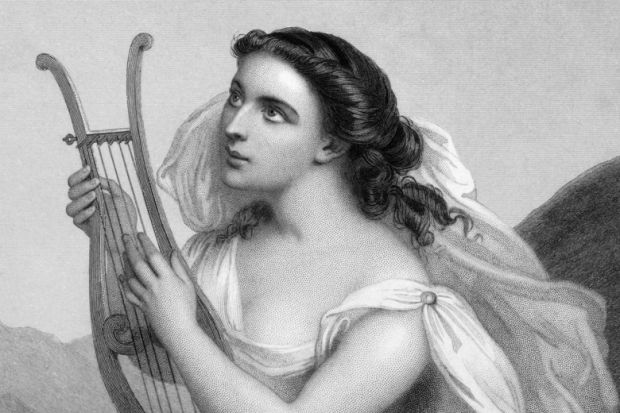We know little about Sappho, the Greek lyric poet who sang of love, girls and her love for girls, in the late 7th century BC. Her contemporary Alcaeus describes her as “crowned-with-violets, divine, sweet-smiling, Sappho”. A papyrus dated to the early 3rd century AD claims that she was “quite ugly: dark in complexion and of very small stature”. The 19th-century philologist Ulrich von Wilamowitz-Moellendorff insists that she was a headmistress in a finishing school for girls. Many see her as a gay icon. Inevitably, these different visions of Sappho reveal more about those who imagine her than about the poet herself. Very little survives of her songs: some quotations preserved in other ancient authors, and a (steadily increasing) number of papyrus scraps retrieved from the sands of Egypt or extracted from mummy cartonnage.
In the only complete poem we have, Sappho remembers how Aphrodite descended from Olympus in a chariot drawn by sparrows, smiled and asked: “Who is it, Sappho,/who has done you wrong?/For even if she runs away, soon she will pursue./If she refuses gifts, she’ll be giving instead./And if she won’t love, she will soon enough,/even against her will.” Most of the fragments are brief: a few lines, sometimes a single word. A teacher of rhetoric of the 2nd century AD writes, for example: “Sappho calls Eros mythoplokos”, ie, “weaver of tales”. This is a beautiful word, and typical of Sappho: it sounds like a traditional epithet (the language of epic and religious cult) but is actually her invention. As for revealing something about her or her context, it gives little away: at all times, and in all places, love weaves many tales.
Ancient biographers constructed the lives of poets primarily out of “clues” they thought they found in their poems. Philip Freeman, rather distressingly, follows the same procedure. I give just one example: in a surviving fragment, Sappho speaks of a pais (“child” or “slave”) named Cleis. Ancient biographers present this Cleis as Sappho’s daughter. A Byzantine encyclopedia adds that Sappho’s mother was also called Cleis (presumably because children are often named after grandparents). Freeman follows suit and declares that Sappho “was married and the mother of a much beloved daughter”. It is not at all clear that Cleis was Sappho’s daughter (although she was described as “beloved”, and “like golden flowers”). As for a husband, there is no mention of one in the fragments. Freeman argues that there must have been a husband, because there was a daughter, after all. He adds that all ancient Greek women married, which is demonstrably untrue: they all had a guardian, but this could be a father or a brother (it may be significant that Sappho’s brothers, unlike her husband, feature in the fragments).
After decades of sophisticated research on the construction of authorial personae in Greek lyric, on the fictional lives of ancient poets, and on real ancient women, it is surprising (as well as disappointing) to read such an uncritical account of Sappho and her world. This book is marketed “for a general audience”, but that should not be an excuse. Freeman’s plain and elegant translations of Sappho’s fragments deserve to be accompanied by a more rigorous and reliable introduction.
Barbara Graziosi is professor of Classics, Durham University. Her new book, Homer, will be published by Oxford University Press in September 2016.
Searching for Sappho: The Lost Songs and World of the First Woman Poet
By Philip Freeman
W. W. Norton, 336pp, £17.99
ISBN 9780393242232
Published 11 March 2016
POSTSCRIPT:
Print headline: The enigma of a weaver of tales
Register to continue
Why register?
- Registration is free and only takes a moment
- Once registered, you can read 3 articles a month
- Sign up for our newsletter
Subscribe
Or subscribe for unlimited access to:
- Unlimited access to news, views, insights & reviews
- Digital editions
- Digital access to THE’s university and college rankings analysis
Already registered or a current subscriber?




